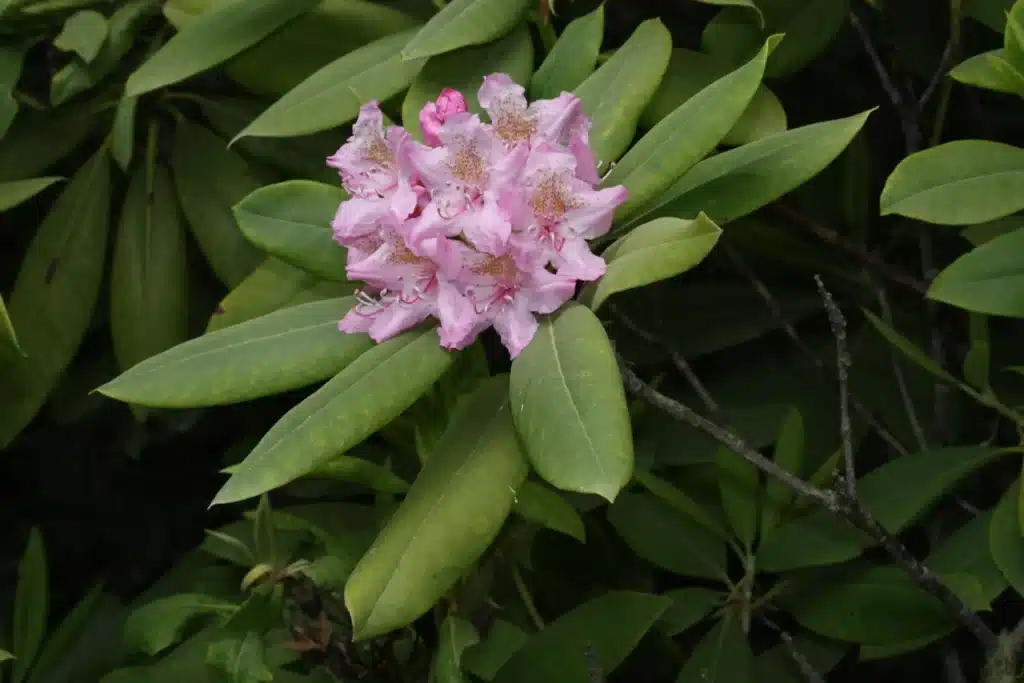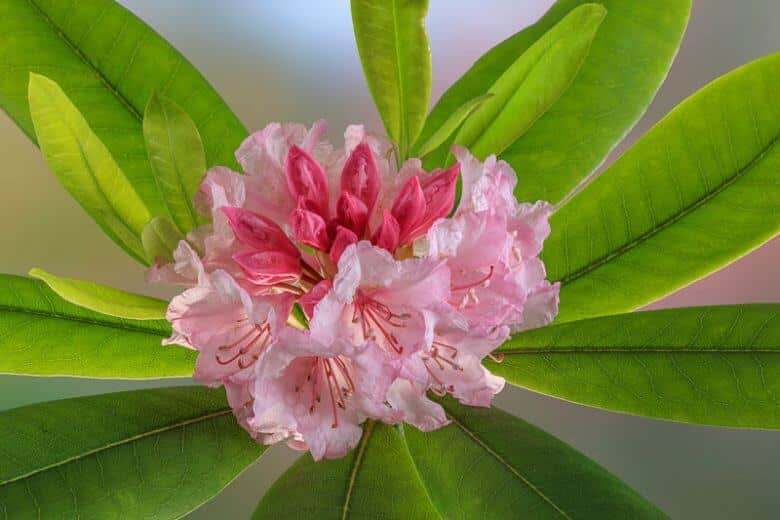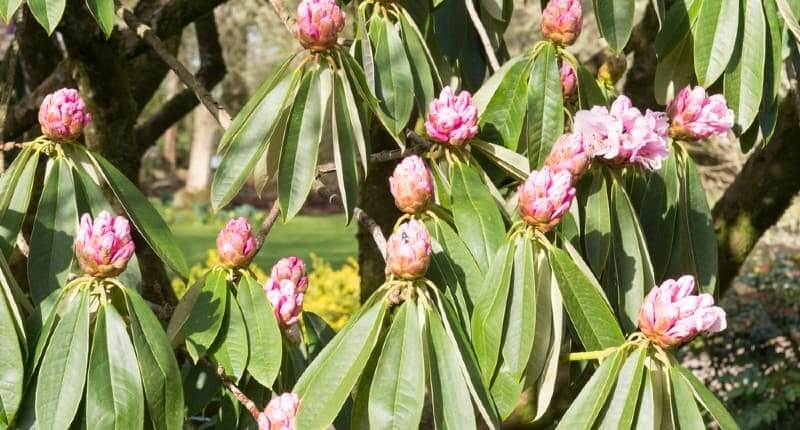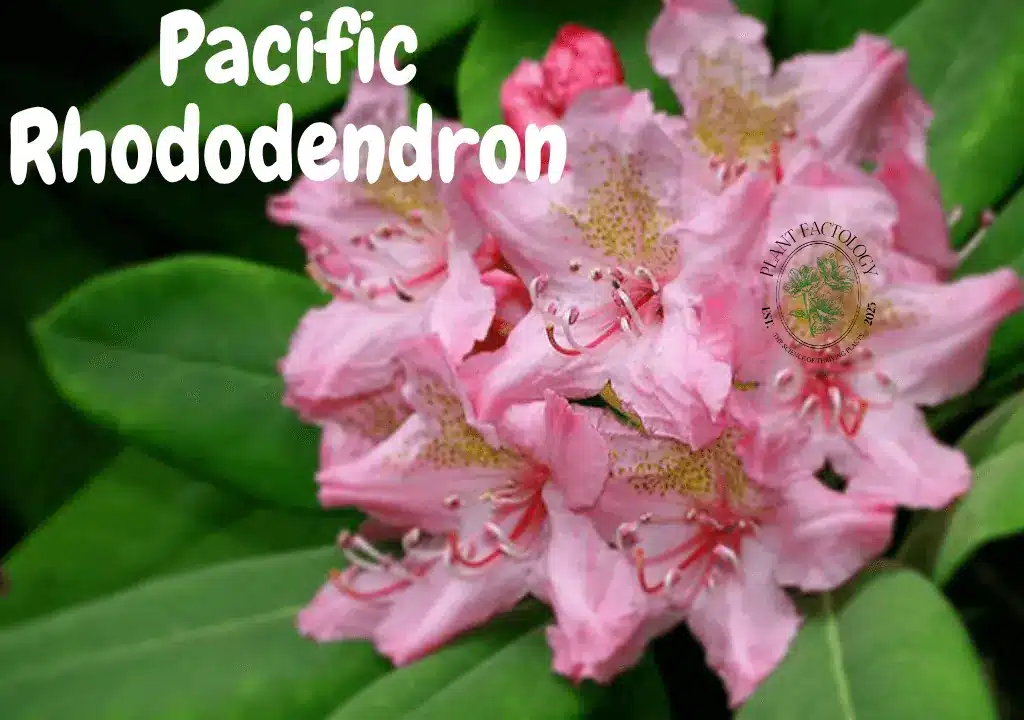The Pacific Rhododendron (Rhododendron macrophyllum) transforms the coastal forests of the Pacific Northwest each spring.
This native evergreen shrub explodes with clusters of pink blossoms that stand out against its deep green foliage.
It represents the region’s wild beauty and ecological resilience. Found nowhere else on Earth naturally, this plant thrives in the unique conditions between British Columbia and Northern California.
As Washington’s state flower and a native ecological pillar, this evergreen shrub thrives where others struggle. Discover its unique traits, historical roots, ways to prune, color variation and how to grow it successfully.
Table of Contents
Identification and Natural History of Pacific Rhododendron
Pacific Rhododendron belongs to the heath family and carries the scientific name Rhododendron macrophyllum, meaning “large-leaved rose tree.”
This description perfectly captures its features like leathery, dark green leaves reaching 4-8 inches long with distinctive rust-colored undersides.
The bell-shaped blossoms cluster in trusses of 10-20 flowers, predominantly showcasing rose-pink to lavender shades, though rare white variants occasionally appear.
In its natural setting, this slow-growing shrub typically reaches 6-12 feet tall but can stretch to 25 feet in optimal conditions. It forms dense thickets through underground runners, creating living barriers that stabilize slopes.

The plant’s leathery foliage persists year-round, providing critical winter shelter for forest creatures. After blooming, woody seed capsules develop, persisting through summer before releasing tiny seeds carried by wind and water.
Distinguishing Features
| Characteristic | Description |
|---|---|
| Leaves | Leathery, deep green (4-8″ long), rust-colored undersides |
| Pacific Rhododendron flowers | Bell-shaped clusters (10-20 blooms); rose-pink to lavender hues |
| Bloom Period | Late May through July |
| Mature Size | 6-12 ft tall; forms dense thickets |
Discover Historical Significance of State Flower
The journey to becoming Washington’s state flower began in the 1920s when women’s garden clubs across the state launched a campaign to recognize this botanical native.
For three decades, advocates highlighted its connection to regional identity, arguing that few plants symbolized Pacific Northwest wilderness more powerfully.

Their persistence paid off when legislators officially designated it as the state floral emblem in May 1959. Today, it stands alongside the western hemlock and orca as icons of Washington’s natural heritage.
Long before this recognition, indigenous communities valued the plant for practical uses. Coastal tribes like the Salish crafted specialized tools from its flexible yet durable wood, while cautiously exploring limited medicinal applications.
Historical records indicate careful preparation methods were developed to mitigate toxicity risks. These traditional uses highlight the deep cultural relationship between native peoples and this remarkable shrub.
Native Habitat & Growing Conditions
Wild Habitat Preferences
- Dappled understory of Douglas fir forests
- Mountain slopes (0-6,000 ft elevation) and stream banks
- Acidic soils (pH 4.5-5.5) with high organic matter
Critical Growth Requirements
- Light: Partial shade (morning sun only)
- Soil: Well-drained, humus-rich soil (amend clay with pine bark)
- Water: Consistent moisture with perfect drainage
- Climate: Coastal fog belt; avoids hot inland areas
Cultivation Guide
Growing Pacific Rhododendron successfully requires mimicking its natural forest habitat. Site selection proves critical—north-facing slopes or east-facing exposures with morning sun and afternoon shade mirror the dappled light of its woodland home.
Soil preparation determines long-term health: amend planting holes with equal parts native soil and acidic organic matter like peat moss or composted pine needles. For heavy clay soils, build raised beds to ensure essential drainage.
Planting Steps
- Site Selection: North-facing slopes or woodland edges
- Soil Prep: Mix 50% native soil with 50% peat moss/pine needles
- Spacing: 8-10 ft between plants
Seasonal Care
- Watering: Deep soak weekly in summer drought
- Mulching: 4″ pine needle layer (regulates acidity)
- Feeding: Acidic fertilizer (e.g., cottonseed meal) in early spring
Pruning Protocol
- When to prune rhododendrons in Pacific Northwest: Late June – early July
- Method: Remove spent blooms only; avoid cutting woody stems
Pacific vs. Hybrid Rhododendrons: Find Key Differences
While garden centers overflow with flashy rhododendron hybrids, the Pacific native offers unique advantages adapted to regional conditions.
Hybrid varieties typically descend from Asian species and struggle in deep shade, requiring more sunlight than Northwest forests provide.
They also demand frequent watering during dry spells, whereas established native plants demonstrate superior drought tolerance once their deep roots establish.

The ecological differences prove equally significant. Showy hybrid blossoms may attract attention but offer little nutritional value to native pollinators.
Pacific Rhododendron flowers specifically nourish local bumblebees and hummingbirds that evolved alongside them.
Unlike shallow-rooted hybrids, the native’s extensive root network stabilizes slopes and survives wildfires. While hybrids boast endless color variations, the Pacific native’s pink-lavender blooms connect gardens to regional wilderness in ways imported plants cannot match.
| Trait | Pacific Native | Common Hybrids |
|---|---|---|
| Origin | PNW wild populations | Asian cultivars |
| Drought Tolerance | High (established plants) | Low |
| Shade Adaptation | Thrives in deep shade | Requires brighter light |
| Flower Colors | Pink/Lavender/White only | Unlimited varieties |
| Wildlife Value | Critical native pollinator support | Minimal ecological role |
Ecological Importance
- Prevents slope erosion with matted root systems
- Nectar source for endangered Bombus vosnesenskii (yellow-faced bumblebee)
- Shelter for spotted towhees and chipmunks
- Fire-adapted: Resprouts from root crown after wildfires
Troubleshooting Common Issues
Pacific Rhododendrons communicate distress through visible symptoms. Leaf scorch appears as crispy brown edges, usually signaling excessive sun exposure.
The solution involves transplanting to shadier locations or creating protective shade structures.

Yellowing leaves with green veins indicate alkaline soil conditions, corrected by applying soil sulfur and acidifying fertilizers containing chelated iron.
| Problem | Cause | Solution |
|---|---|---|
| Leaf Scorch | Afternoon sun exposure | Transplant to shadier site |
| Yellow Leaves | Alkaline soil/iron deficiency | Apply soil sulfur; use acid fertilizer |
| Root Rot | Poor drainage | Raise planting bed; add perlite |
| No Blooms | Late frost damage | Avoid pruning after August |
Frequently Asked Questions
Are rhododendrons native to the Pacific Northwest?
Yes, Rhododendron macrophyllum is endemic to coastal forests from British Columbia to Northern California.
Why was this specific plant chosen as Washington’s state flower?
After a 30-year advocacy campaign by women’s garden clubs, legislators adopted it in 1959 for its symbolic connection to the region’s wilderness heritage and breathtaking spring displays.
When should I prune my Pacific Rhododendron?
Prune only in late June or early July immediately after blooming. Later pruning removes next year’s flower buds already forming at stem tips.
Can it grow in full sun?
No. Morning sun with afternoon shade replicates its natural forest understory habitat.
How toxic is this State flower?
All parts contain grayanotoxins harmful to humans and animals if ingested. Symptoms range from nausea to cardiac issues. Deer naturally avoid browsing it.
What makes its flowers ecologically special?
Unlike hybrid varieties, its May-July blooming period provides critical nectar when few native flowers are available, specifically supporting endangered bumblebee species.



